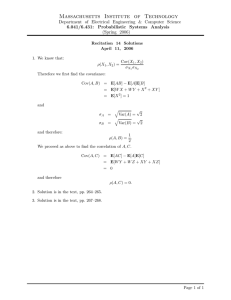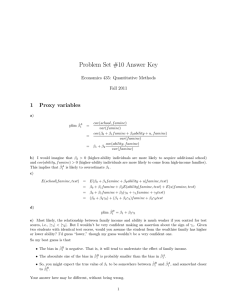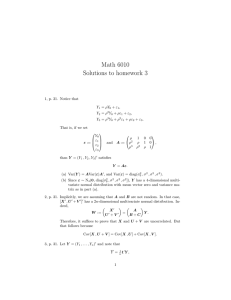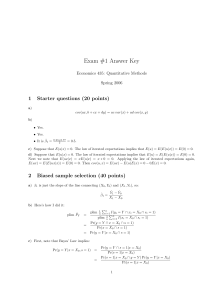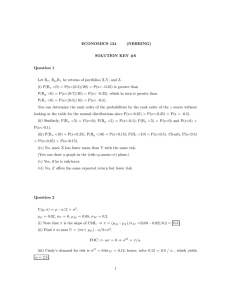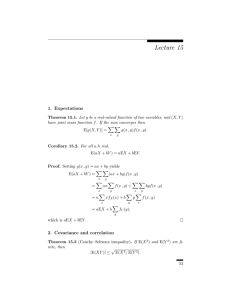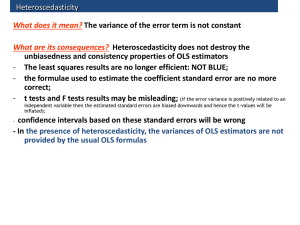Lecture 6 Heteroscedasticity and Autocorrelation Research Methods
advertisement
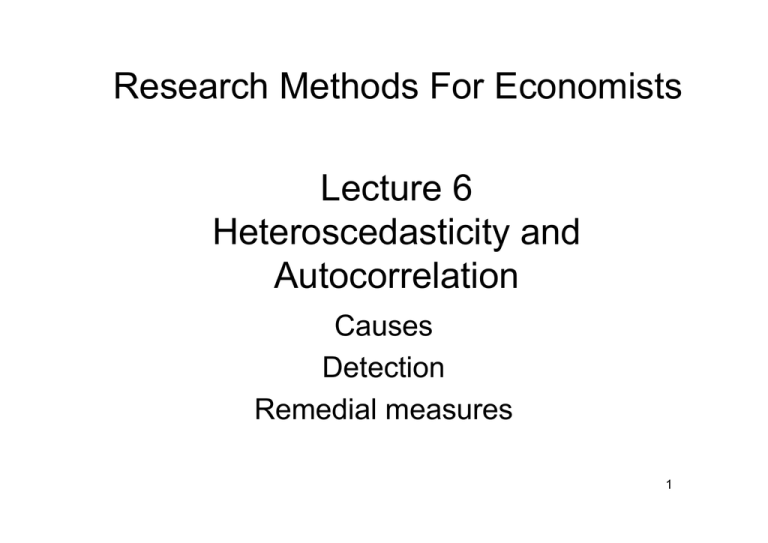
Research Methods For Economists Lecture 6 Heteroscedasticity and Autocorrelation Causes Detection Remedial measures 1 Assumptions of a Regression Model Yi = β1 + β 2 X i + ei E [ei ] = 0 cov(ei e j ) = 0 var[ei ] = σ 2 for all i ≠ j E [ei X i ] = 0 Xi is exogenous, not random 2 Why variance of errors may change over time? •Learning reduces errors; driving practice, driving errors and accidents typing practice and typing errors, defects in productions and improved machines •Improved data collection: better formulas and goods softw •More heteroscedasticity exists in cross section than in time series data. 3 Homoscedasticity 2 i eˆ . . . . . . . . . . . . .. . . . . . . . . . . . . Y 4 Hetroscedasticity -Y1 2 i eˆ . . . . . . . . . . . Y 5 Hetroscedasticity -X1 2 i eˆ . . . . . . . . . . . X 6 Hetroscedasticity -Y2 2 i eˆ . . . . . . Y 7 Hetroscedasticity -X2 2 i eˆ . . . . . . X 8 Hetroscedasticity -Y3 2 i eˆ . . . . . . . Y 9 Hetroscedasticity -X3 2 i eˆ . . . . . . . X 10 Hetroscedasticity -Y4 2 i eˆ . . . . . . . . . Y 11 Hetroscedasticity -X4 2 i eˆ . . . . . . . . . X 12 Hetroscedasticity -Y5 σˆ 2 i . . . . . . . . . . . . . Y 13 Hetroscedasticity -X5 σˆ 2 i . . . . . . . . . . . . . X 14 Y Meaning of Homoscedasticity var[e5 ] = σ 2 var[e4 ] = σ 2 Yi = β1 + β 2 X i + ei e2 e3 e4 e5 var[e3 ] = σ 2 var[e2 ] = σ 2 e1 var[e ] = σ 2 i Same Variance of error across all X 15 X Meaning of Heteroscedasticity Y var[e4 ] = σ var[e5 ] = 2 Yi = β1 + β 2 X i + ei e3 e2 e4 e5 var[e3 ] = σ 32 var[e2 ] = σ 22 e1 var[e ] = σ i 2 1 Variance of Error Terms Varies by value of X X 16 Nature and Causes ⎡e ⎤ = σ 2 e var • LS assumption: variance of i is constant for ⎢⎣ i ⎥⎦ every ith observation, ⎤ ⎡ ⎥ ⎢ ⎥ 1 ⎛ ˆ ⎞ ˆ 2⎢ var⎜ β ⎟ = σ ⎢ ⎥ 2 ⎝ 2⎠ ⎥ ⎢ ⎛ ⎞ ⎢ ∑ ⎜⎝ xi − x ⎟⎠ ⎥ ⎥⎦ ⎢⎣ i but it is possible that σi2 = σ 2xi Causes: Learning, growth, improved data collection, outliers, omitted variables; 17 Linear, Unbiasedness and Minimum Variance Properties of an Estimator (BLUE Property) ∑ ⎛⎜⎝ X i − X ⎞⎟⎠Yi = ∑ wiYi Linearity: β̂ 2 = 2 ∑ ⎛⎜⎝ X i − X ⎞⎟⎠ Unbiasedness E⎛⎜⎜ βˆ1⎞⎟⎟ = β1 ⎝ ⎠ ( ) f βˆ1 Minimum Variance ⎡ ⎤ ⎢ ⎥ ⎢ ⎥ ⎛ ˆ ⎞ 1 2 ⎢ ⎥ var⎜⎜ β ⎟⎟ = σˆ ⎢ 2 2⎥ ⎝ ⎠ ⎢ ⎛⎜ X − X ⎞⎟ ⎥ ⎢∑⎝ i ⎠ ⎥ ⎣i ⎦ ( ) f βˆ1 βˆ2 ( ) E βˆ1 = β1 Bias Bias βˆ3 18 Consequences of Hetroscedasticity OLS Estimate is Unbiased But it is no longer efficient ( ) E βˆ2 = β 2 ( ) [ ⎡ ⎤ ˆ E β 2 = E ∑ wi yi = E ⎢∑ wi (β1 + β 2 xi + ei )⎥ ⎣ ⎦ = E ∑ wi β1 + β 2 ∑ wi xi + ∑ wi ei = β 2 ] [ var ] (βˆ ) = 2 ∑ (x i − x )2 σ 2 i i ⎡ ⎢∑ ⎣ i (x i − x )2 ⎤ ⎥ ⎦ 2 19 Tests for Heteroscedasticity Glejser test Yi = β 1 + β 2 xi + ei There are several tests ei = β 1 + β 2 X i + v i ei = β 1 + β 2 X i + v i 1 + vi Xi 1 ei = β 1 + β 2 + vi Xi ei = β 1 + β 2 ei = β1 + β 2 X i + vi ei = β1 + β 2 X i2i + vi In each case do t-test H0: β =0 against HA: β ≠ 0 . If β is significant then that is the evidence of heteroscedasticity. Goldfeld-Quandt test Model Yi = β 1 + β 2 xi + ei (1) Steps: 1. Rank observations in ascending order of one of the x variable 2. Omit c numbers of central observations leaving two groups with n−c number of osbervations 2 n−c and the last 3. Fit OLS to the first 2 n−c observations and find sum of 2 the squared errors from both of them. 4. Set hypothesis H :σ 2 = σ 2 0 1 2 H :σ 2 ≠ σ 2 . A 1 2 5. compute λ = distribution. against ERSS 2 df 2 it follows F ERSS1 df 1 20 Tests for Heteroscedasticity There are a series of formal methods developed in the econometrics literature to detect the existence of Heteroscedasticity in a given regression model. Spearman’s rank correlation test Park test Model Yi = β1 + β 2 xi + ei (1) v β 2 2 i Error square: σ = σ x e i i (2) Or taking log ln σ i2 = ln σ 2 + β ln xi + vi (2’) steps : run the OLS regression for (1) and get the estimates of error terms Square ei . ei , and then run a regression of 2 e ln i with x variable. Do t-test H0: β =0 ⎡ ∑ d i2 ⎤ ⎥ rs = 1 − 6 ⎢ i 2 ⎢n n −1 ⎥ ⎥⎦ ⎢⎣ ( steps: 1. run OLS of y on x. 2. obtain errors e 3. rank e and y or x 4. find the difference of the rank 5. use t-statistics if ranks are significantly different assuming n>8 and rank correlation β against HA: β ≠ 0 . If is significant then that is the evidence of heteroscedasticity. ) coefficient t= rs n − 2 1− r If tcal > tcrit there is heteroscedasticity. 2 s ρ =0. with df (n-2) 21 Tests for Heteroscedasticity There are a series of formal methods developed in the econometrics literature to detect the existence of Heteroscedasticity in a given regression model. Spearman’s rank correlation test Park test Model Yi = β1 + β 2 xi + ei (1) v β 2 2 i Error square: σ = σ x e i i (2) Or taking log ln σ i2 = ln σ 2 + β ln xi + vi (2’) steps : run the OLS regression for (1) and get the estimates of error terms Square ei . ei , and then run a regression of 2 e ln i with x variable. Do t-test H0: β =0 ⎡ ∑ d i2 ⎤ ⎥ rs = 1 − 6 ⎢ i 2 ⎢n n −1 ⎥ ⎥⎦ ⎢⎣ ( steps: 1. run OLS of y on x. 2. obtain errors e 3. rank e and y or x 4. find the difference of the rank 5. use t-statistics if ranks are significantly different assuming n>8 and rank correlation β against HA: β ≠ 0 . If is significant then that is the evidence of heteroscedasticity. ) coefficient t= rs n − 2 1− r If tcal > tcrit there is heteroscedasticity. 2 s ρ =0. with df (n-2) 22 Tests for Heteroscedasticity Breusch-Pagan,Godfrey test Yi = β 1 + β 2 x 2,i + .. + β k x k ,i + ei 1.run OLS and obtain error squares 2. Obtain average error square ˆ2 e σ~ 2 = i n 3. regress and eˆ 2 pi = i σ~ 2 pi on a set of explanatory variables pi = α + α x + .. + α x +e 1 2 2, i k k, i i 4. obtain squares of explained sum (EXSS) 1 5. θ = (EXSS ) 2 1 (EXSS ) ≈ χ m2 −1 6. θ = m −1 H : α = α = .. = α = 0 No 0 2 2 k heteroscedasticity and σ 2 = α a 1 i constant. If calculated χ m2 −1 is greater than table value there is an evidence of heteroscedasticity. White Test This is a more general test Model Yi = β 1 + β 2 x 2,i + β 3 x3,i + ei Run OLS to this and get eˆ i eˆi2 = α 1 + α 2 x 2,i + α 3 x3,i + α 4 x22,i + α 5 x32,i α 6 x 2,i x3,i + vi Compute the test statistics n.R 2 ~ χ df2 Again if the calculated χ df is greater than table value there is an evidence of heteroscedasticity. 2 23 ARCH-GARCH Tests Yt = β 1 + β 2Yt −1 + β 3 X t + β 4 X t −1 + ε t ARCH(p) Process σ = α0 +α ε 2 t 2 1 t −1 +α ε 2 2 t −2 +α ε 2 3 t −3 + ... + α ε 2 p t− p GARCH(p,q) Process σ t2 = α 0 + α 1ε t2−1 + α 2ε t2−2 + α 3ε t2−3 + ... + α p ε t2− p + φ1σ t2−1 + φ 2σ t2−2 + φ 3σ t2−3 + ... + φ qσ t2−q 24 Hetroscedasticity and Autocorrelation Depends on the Variance Covariance Terms of the Error Term ⎡ var(e1 ) cov(e1e2 ) cov(e1e3 ) cov(e1e4 ) cov(e1e5 )⎤ ⎢cov(e e ) var(e ) cov(e e ) cov(e e ) cov(e e )⎥ 2 1 2 2 3 2 4 2 5 ⎥ ⎢ E [ee'] = ⎢cov(e3 e1 ) cov(e3 e2 ) var(e3 ) cov(e3 e4 ) cov(e3 e5 )⎥ ⎥ ⎢ ( ) ( ) ( ) ( ) ( ) cov cov cov var cov e e e e e e e e e 4 1 4 2 4 3 4 4 5 ⎥ ⎢ ⎢⎣cov(e5 e1 ) cov(e5 e2 ) cov(e5 e3 ) cov(e5 e4 ) var(e5 ) ⎥⎦ ⎡σ 11 ⎢σ ⎢ 21 E [ee'] = ⎢σ 31 ⎢ ⎢σ 41 ⎢⎣σ 51 σ 12 σ 22 σ 32 σ 42 σ 52 σ 13 σ 23 σ 33 σ 43 σ 53 σ 13 σ 24 σ 34 σ 44 σ 54 σ 14 ⎤ σ 25 ⎥⎥ σ 35 ⎥ ⎥ σ 45 ⎥ σ 55 ⎥⎦ ⎡σ 12 0 0 0 0⎤ ⎥ ⎢ 2 0 σ 0 0 0 2 ⎥ ⎢ 2 E [ee'] = ⎢ 0 0 σ3 0 0⎥ ⎥= ⎢ 2 0 0 0 σ 0 ⎥ ⎢ 4 ⎢0 0 0 0 σ 52 ⎥⎦ ⎣ E[ee'] = σ I 2 t 25 Remedial Measures 2 σ Weighted Least Square and GLS when i known, divide the whole equation by σ i Apply OLS to transformed variables. β Y X X e X X X i = 0 +β 1+β k + i 3 +β 2 +β 4 + ....... + β 1 2 3 4 k σ σ σ σ σ σ σ σ i i i i i i i i Variance of this transformed model equals 1. 2 2 2 Other examples: Yi = β 1 + β 2 xi + ei and assume ei = σ xi Y i = x i β e 1+β + i 2 x x i i ; ⎛e ⎜ E⎜ i ⎜x ⎝ i 2 ⎞ ⎟ σ 2 xi2 2 ⎟ = 2 =σ xi ⎟ ⎠ * * * In Matrix notation: PY = PXβ + Pe ; P' P = Ω −1 and Y = X β + e β̂ = ⎛⎜ X * ' X * ⎞⎟ GLS ⎝ ⎠ β̂ GLS = −1 X * ' Y * = aY ⎛ − 1 X ⎞⎟ ⎜ X 'Ω ⎝ ⎠ −1 X ' Ω − 1Y = aY where Ω−1 is a variance-covariance matrix 2 σ which makes the residual constant throughout all observations. when unknown estimate σ using the sample information and do the above procedures (Gujarati is a good text for Heteroscedasticity). 2 26 Density 2.5 Errors in Work- hours on Pay and Taxes Detection: Graphical Method r:WHRS N(0,1) 2.0 1.5 1.0 0.5 -1.5 -1.0 -0.5 0.0 0.5 1.0 1.5 2.0 2.5 3.0 3.5 4.0 4.5 5.0 5.5 27 WHRS = + 16.86 + 0.0002153*PAY - 0.001377*TAX (SE) (0.298) (0.00039) (0.00119) sigma 19.9025 RSS 2681268.38 R^2 0.00028724 F(2,6769) = 0.9724 [0.378] log-likelihood -29861.6 DW 1.81 no. of observations 6772 no. of parameters 3 mean(WHRS) 16.7634 var(WHRS) 396.048 Errors are not normal Normality test: Chi^2(2) = 2147.0 [0.0000]** NO Presence of Heteroscedasticity hetero test: F(4,6764)= 1.2780 [0.2761] hetero-X test: F(5,6763)= 1.0353 [0.3948] RESET test: F(1,6768)=0.0042512 [0.9480] 28 Correction of Heteroscedasticity Heteroscedasticity consistent standard errors Coefficients SE HACSE HCSE JHCSE Constant 16.856 0.29808 0.31282 0.27802 0.28423 PAY 0.00021532 0.00039000 0.00031787 0.00032990 0.0003866 TAX -0.0013765 0.0011895 0.0010469 0.0010719 0.0012026 Coefficients Constant 16.856 PAY 0.00021532 TAX -0.0013765 t-SE t-HACSE t-HCSE t-JHCSE 56.550 53.884 60.629 59.306 0.55210 0.67739 0.65268 0.55685 -1.1572 -1.3148 -1.2842 -1.1446 29 Regression of Pay on Workhours and Tax Payment among British Households PAY = + 308 + 0.2091*WHRS + 2.565*TAX (SE) (10.6) (0.379) (0.0201) R^2 0.707293 F(2,6769) = 8178 [0.000]** log-likelihood -53152.3 DW 1.97 no. of observations 6772 no. of parameters 3 mean(PAY) 809.312 var(PAY) 1.31373e+006 Errors are not Normal and not Homoscedastic Normality test: Chi^2(2) =3.3707e+005 [0.0000]** hetero test: F(4,6764)= 696.91 [0.0000]** hetero-X test: F(5,6763)= 564.35 [0.0000]** RESET test: F(1,6768)= 306.40 [0.0000]** Sample from the BHPS 30 Hetroscedasticity Consistent Standard Errors: While Tests Heteroscedasticity consistent standard errors Coefficients SE HACSE HCSE JHCSEConstant 307.97 10.633 58.458 58.086 64.117WHRS 0.20913 0.37878 0.28170 0.29554 0.29859TAX 2.5652 0.020059 0.31721 0.31539 0.34842 t-JHCSEConstant 4.8032WHRS 0.70039TAX 7.3624 Coefficients t-SE t-HACSE t-HCSE 307.97 28.965 5.2681 5.3019 0.20913 0.55210 0.74237 0.70760 2.5652 127.88 8.0869 8.1337 31 Some Heteroscedasticity Tests in Shazam *GLS estimation *Weighted Least Square estimation *Glejser-Harvey-Pagan and ARCH tests ols y x1 x2 / diagnos/het *Harvey and Phillips tests ols y x1 x2 / diagnos/recur *Chow and Godfrey and Quandt test ols y x1 x2 / diagnos/chowone=5 *Jackknife test ols y x1 x2 /cov=b anova diagnos/jackknife *Ramsey reset specification test ols y x1 x2 /cov=b anova diagnos/reset 32 Autocorrelation Causes Consequences Remedies 33 Assumptions of a Regression Model Yi = β1 + β 2 X i + ei E [ei ] = 0 cov(ei e j ) = 0 var[ei ] = σ 2 for all i ≠ j E [ei X i ] = 0 Xi is exogenous, not random 34 Linear, Unbiasedness and Minimum Variance Properties of an Estimator (BLUE Property) ∑ ⎛⎜⎝ X i − X ⎞⎟⎠Yi = ∑ wiYi Linearity: β̂ 2 = 2 ∑ ⎛⎜⎝ X i − X ⎞⎟⎠ Unbiasedness E⎛⎜⎜ βˆ1⎞⎟⎟ = β1 ⎝ ⎠ ( ) f βˆ1 Minimum Variance ⎡ ⎤ ⎢ ⎥ ⎢ ⎥ ⎛ ˆ ⎞ 1 2 ⎢ ⎥ var⎜⎜ β ⎟⎟ = σˆ ⎢ 2 2⎥ ⎝ ⎠ ⎢ ⎛⎜ X − X ⎞⎟ ⎥ ⎢∑⎝ i ⎠ ⎥ ⎣i ⎦ ( ) f βˆ1 βˆ2 ( ) E βˆ1 = β1 Bias Bias βˆ3 35 What is an autocorrelation? ei e = ρe + v i i−1 i . . . . . . . ρ <0 . . . . 0 . Time 36 What is an autocorrelation? ei e = ρe + v i i−1 i . . . . . . . ρ <0 . . . . 0 . Time 37 What is an autocorrelation? ei e = ρ e + ρ e +v i 1 i−1 2 i−2 i . . . . . Time 38 What is autocorrelation? Assumption behind the OLS cov(e e ) = 0 for all i ≠ j i j Autocorrelation exists when ρ cov(e e ) ≠ 0 for all i ≠ j i j ⎛ ⎞ e = ρe + v 2 ⎜ ⎟ ~ 0 , v N σ i i ⎜ ⎟ i−1 i ⎝ ⎠ correlation coefficient between –1 and 1 39 Causes, consequences and Remedial measures for Autocorrelatio Causes: inertia , specification bias, cobweb phenomena manipulation of data. Consequences Estimators are still linear and unbiased but they there not the best, they are inefficient. ρ ρ Remedial measures: When Is known Transformation the model When is unknown estimate it and transform the model 40 Variance of the error term with AR(1) Process ⎛ ⎜ ⎜ ⎝ ⎞ ⎟ ⎟ ⎠ var e = var ρe +v = ρ2 var⎛⎜⎜e ⎞⎟⎟ + var⎛⎜v ⎞⎟ i ⎝ i⎠ i −1 i ⎝ i−1⎠ ⎛ ⎞ + 2cov⎜⎜e v ⎟⎟ ⎝ i−1 i ⎠ 2 σ σ e2 = ρ 2σ e2 +σ v2 => σ e2 = v 1− ρ 2 ⎛ ⎜⎜ ⎝ ⎞ ⎟⎟ ⎠ Specifically: ρ= cov⎛⎜ et e ⎞⎟ ⎝ t−1⎠ var(et ) var⎛⎜ e ⎞⎟ ⎝ t−1⎠ ; cov⎛⎜ et e ⎞⎟ = ρσe2 ⎝ t−1⎠ (9.3) 41 Durbin-Watson (DW) test 2 2 − 2 eˆ eˆ 2 T⎛ ˆ ˆ + e e ⎞ ∑ ∑ ∑ ∑ ⎜⎝ eˆt − eˆt −1 ⎟⎠ t t t −1 t −1 i i i i ˆ = ≈ 2(1 − ρ̂ ) d= 2 2 ∑ eˆt ∑ eˆt i i 2 2 ∑ eˆt −1 ≈ ∑ eˆt i i 2 2 2 eˆ eˆ ˆ ˆ e e ∑ t t −1 ∑ t −1 ∑ t = (2 − 2 ρ ) = 2(1− ρˆ ) +i − i dˆ = i 2 2 2 ∑ eˆt ∑ eˆt ∑ eˆt i i i d = 0; ρ = 1 d = 2; ρ = 0 (9.8) d = 4; ρ = −1 42 Durbin-Watson (DW) test 2 T ⎛ ˆ 2 − 2 ∑ eˆ eˆ ˆ2 e e + ⎞ ∑ ∑ ˆ ˆ e e − ∑ ⎜⎝ t t t t −1 t −1 t −1 ⎟⎠ i i i i ˆ d = = ≈ 2 (1 − ρ̂ ) 2 2 ˆ ∑ et ∑ eˆt i i Values of DW depend on number of parameters in the Model, K, and observations Inconclusive region Inconclusive region d = 0; ρ = 1 dL No auto-correlation dU Positive autocorrelation d = 2; ρ = 0 4 − dU 4 − d L d = 4; ρ = −1 Negative autocorrelation 43 Consequence of Autocorrelation OLS Estimator is still linear and unbiased. Variance is large that makes t-statistic insignificant Proof: ( ) [ ( ] ⎡ E βˆ = E ∑ wi yi = E ⎢∑ wi β + β xi + ei 2 1 2 ⎣ )⎤⎥⎦ = E[∑ wi β1 + β 2 ∑ wi xi + ∑ wiei ]= β 2 2 ( ) [( ) ] [∑ w e ] var βˆ 2 = E E βˆ 2 − β 2 = E 2 i i 2 ⎡ ⎤ ⎡ ⎤ (xi − x ) ⎥ E (e )2 + 2 ⎢ (xi − x ) ⎥ E (e e ) = ⎢ = ⎢∑ ∑ i i j 2 2 ⎢ ( ( xi − x ) ⎥ xi − x ) ⎥ ∑ ∑ ⎢⎣ ⎥⎦ ⎢⎣ ⎥⎦ i i 2 ⎡ ⎤ ⎡ ⎤ ( ) ( ) − − x x x x ( xi − xi ) ⎥ 2 ⎢ ⎢ i i i j ⎥ 2 s + σ 2 σ ρ 2 ⎢ ∑ ( x − x )2 ⎥ ⎢∑ ⎥ ( xi − xi ) ⎥ ∑ i i ⎢⎣ ∑ ⎥ ⎢ i i ⎦ ⎣ ⎦ = σˆ 2 ∑ (x i 1 i − x) 2 ⎡ xi xi −1 ∑ ⎢1 + ρ i 2 + 2 ρ ⎢ xi2 ∑ ⎢⎣ i ∑x x ∑x i i −1 i 2 i i + .... + 2 ρ n −1 ∑x x ∑x i i −1 i 2 i i ⎤ ⎥ ⎥ ⎥⎦ 44 Remedial Measure when ρ is Known Take a lag of the original model; and multiply it by ρ ; and subtract from the original model to find a transformed model. ρY = ρβ + ρβ x + ρe t −1 1 2 t −1 t −1 Yt −ρY = β −ρβ +β x −ρβ x +e −ρe t−1 1 1 2 t−1 2 t−1 t−1 t− Transformed model Y * = β * + β * x* + e* Where t 1 2 t t Yt* = Yt − ρY ; X t* = X t − ρX ; t −1 t −1 et* = et − ρe ; β * = β − ρβ . 1 1 t −1 OLS estimates unknown parameters of this transformed model will be BLUE. Retrieve β 1 of the original model from estimates of β * . 45 Cochrane-Orcutt iterative procedure This method is similar to the above ones, except that it involves multiple iteration for estimating ˆ ˆ β β 1. Estimate 1 and 2 estimate ρ̂ i ρ̂ i . Steps are as following: the original model; get error terms and 2. Transform the original model multiplying it by first difference, ˆˆ β ρ̂ i and by taking the ˆ βˆ 2 1 and from the transformed model and get errors 3. Estimate of this transformed model 4. Then again estimate original model ρ̂ˆ i and use those values to transform the Yt − ρˆ Y = β − ρˆ β + β x − ρˆ β x +e − ρˆ e t −1 1 1 2 t −1 2 t −1 t −1 t −1 . ρ converges; ρ̂ˆ i =0. 5. Continue this iteration process until Diagnos /ACF options in OLS in Shazam will generate these iterations. 46 Relation between Exchange Rate and the Interest Rate in UK ER = + 1.555 + 0.03491*RPI (SE) (0.0458) (0.00469) R^2 0.319598 F(1,118) = log-likelihood -22.354 DW 55.43 [0.000]** 0.102 Tests suggest that Errors are not normal: Errors are autocorrelated and hetroscedastic dU ,(1,150) = 1.746 AR 1-5 test: F(5,113) = 150.53 [0.0000]** ARCH 1-4 test: F(4,110) = 183.65 [0.0000]** d L ,(1,150 ) = 1.720 Normality test: Chi^2(2) = 15.844 [0.0004]** hetero test: F(2,115) = 5.8804 [0.0037]** hetero-X test: F(2,115) = 5.8804 [0.0037]** RESET test: F(1,117) = 13.176 [0.0004]** 47 Evidence of positive autocorrelation (PcGive resutls) Transformation of the model by the first difference Exchange Rate and the Interest Rate DER = - 0.006429 + 0.009026*DRPI (SE) (0.00778) (0.00506) R^2 0.0264972 F(1,117) = log-likelihood 125.689 DW 3.185 [0.077] 1.62 AR 1-5 test: F(5,112) = 1.1384 [0.3444] ARCH 1-4 test: F(4,109) = 0.72343 [0.5778] Normality test: Chi^2(2) = 9.1530 [0.0103]* hetero test: F(2,114) = 1.6454 [0.1975] hetero-X test: F(2,114) = 1.6454 [0.1975] RESET test: F(1,116) = 0.055692 [0.8139] Autocorrelation has gone but the relation has disappeared. 48 Transformation of the model by the first difference Exchange Rate and the Interest Rate DER = - 0.006429 + 0.009026*DRPI (SE) (0.00778) (0.00506) R^2 0.0264972 F(1,117) = log-likelihood 125.689 DW 3.185 [0.077] 1.62 AR 1-5 test: F(5,112) = 1.1384 [0.3444] ARCH 1-4 test: F(4,109) = 0.72343 [0.5778] Normality test: Chi^2(2) = 9.1530 [0.0103]* hetero test: F(2,114) = 1.6454 [0.1975] hetero-X test: F(2,114) = 1.6454 [0.1975] RESET test: F(1,116) = 0.055692 [0.8139] Autocorrelation has gone but the relation has disappeared. 49 Illustration of Shazam Program Autocorrelation Corrected Estimations read year y m4 p 1970 418032 26643 l r 19.6 23797 6.56 dim w1 32 ols y p l/list resid=w1 diagnos/ACF matrix w=diag(w1) matrix ww=w*w auto y p l/order=8 list *maximum likelihood estimator auto y p l/ml *Cochrane-Orcutt iterative procedure auto y p l/iter=20 *Generalised list square estimator gls y p l /pmatrix=ww Stop 50 51
